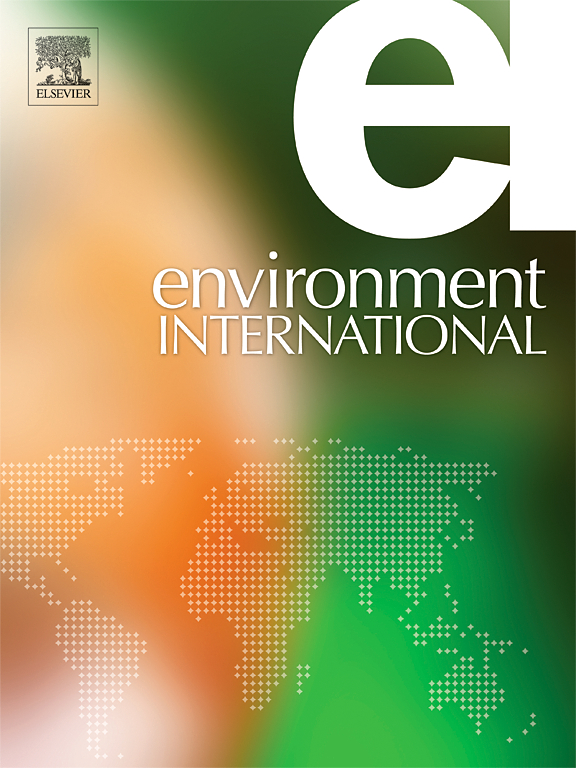揭示人类头发中的新型和遗留PFAS
IF 9.7
1区 环境科学与生态学
Q1 ENVIRONMENTAL SCIENCES
引用次数: 0
摘要
对全氟烷基和多氟烷基物质(PFAS)进行人体生物监测的最新方法是对人类头发进行非侵入性采样。本研究采用固相萃取(SPE)、液相色谱-串联质谱(UPLC-MS/MS)技术对人发中的PFAS进行了测定。对来自德国自愿受试者的45份头发样本(19名女性,26名男性)进行了26种目标化合物筛选,包括全氟烷基羧酸(PFCAs)、全氟烷基磺酸(PFSAs)、氟端聚体磺酸(FTSAs)、氟端聚体羧酸(FTCAs)、氟端聚体不饱和羧酸(FTUCAs)、多氟烷基磷酸二酯(dipap)、全氟辛烷磺酰胺(FOSA)、n -乙基全氟辛烷磺酰胺乙酸(N-EtFOSAA)和双(三氟甲烷)磺酰亚胺(NTf2)。26个目标分析物中有22个在每个样品中检测到2至16个PFAS。最常检测到的物质为6:2 FTSA、PFOS、PFOA和6:2 diPAP,检测频率(Df)分别为93、87、84和78 %。在44. %的样品中发现了新出现的离子液体成分NTf2,这表明它的存在范围很广。据我们所知,NTf2首次在人类头发中被检测到。每个受试者的PFAS总浓度范围为121 pg/g至10332 pg/g。最大浓度为全氟辛烷磺酸(3763 pg/g), 6:2 FTSA(3600 pg/g)和PFPeS(3154 pg/g)。与30 岁的年轻受试者(∑PFAS中位数为1196 pg/g,∑PFSAs中位数为453 pg/g)相比,30 岁的年轻受试者的∑PFAS(中位数为2231 pg/g)和∑PFSAs(中位数为735 pg/g)水平明显更高。该研究表明,除了普遍监测的PFCAs和pfsa外,其他前体如dip、ftsa及其转化产物也对头发中的PFAS总量有很大贡献。这反映了人类对PFAS的暴露,即使血液-毛发转移因素尚未确定,受试者选择也不能代表整个德国人口。本文章由计算机程序翻译,如有差异,请以英文原文为准。

Unveiling novel and legacy PFAS in human hair
A recent approach for human biomonitoring of per- and polyfluoroalkyl substances (PFAS) is non-invasive human hair sampling. In this study, solid-phase extraction (SPE), liquid-chromatography and tandem mass spectrometry (UPLC-MS/MS) were used to measure an extended set of PFAS in human hair. 45 hair samples from German voluntary subjects (19 female, 26 male) were screened for 26 target compounds, including perfluoroalkyl carboxylic acids (PFCAs), perfluoroalkylsulfonic acids (PFSAs), fluorotelomer sulfonic acids (FTSAs), fluorotelomer carboxylic acids (FTCAs), fluorotelomer unsaturated carboxylic acids (FTUCAs), polyfluoroalkyl phosphate diesters (diPAPs), perfluorooctanesulfonamide (FOSA), N-ethyl perfluorooctane sulfonamidoacetic acid (N-EtFOSAA) and bis(trifluoromethane)sulfonimide (NTf2). 22 out of 26 target analytes were detected with two to 16 PFAS per sample. The most frequently detected substances were 6:2 FTSA, PFOS, PFOA and 6:2 diPAP with detection frequencies (Df) of 93, 87, 84, and 78 %, respectively. The emerging ionic liquid ingredient NTf2 was found in 44 % of all samples, which points to its widespread occurrence. To the best of our knowledge, NTf2 has been detected for the first time in human hair. The PFAS sum concentrations per subject ranged from 121 pg/g to 10332 pg/g. Maximum concentrations were found for PFOS (3763 pg/g), 6:2 FTSA (3600 pg/g) and PFPeS (3154 pg/g). Young subjects <30 years showed significantly higher levels for the ∑PFAS (median 2231 pg/g) and the ∑PFSAs (median 735 pg/g) compared to subjects >30 years (median ∑PFAS 1196 pg/g, and for ∑PFSAs 453 pg/g). This study demonstrates that in addition to the generally monitored PFCAs and PFSAs further precursors like diPAPs, FTSAs, and their transformation products considerably contribute to the total PFAS pattern in hair. This reflects the PFAS exposure of humans, even if blood-hair transfer factors are not yet established for PFAS and subject selection was not representative for the whole German population.
求助全文
通过发布文献求助,成功后即可免费获取论文全文。
去求助
来源期刊

Environment International
环境科学-环境科学
CiteScore
21.90
自引率
3.40%
发文量
734
审稿时长
2.8 months
期刊介绍:
Environmental Health publishes manuscripts focusing on critical aspects of environmental and occupational medicine, including studies in toxicology and epidemiology, to illuminate the human health implications of exposure to environmental hazards. The journal adopts an open-access model and practices open peer review.
It caters to scientists and practitioners across all environmental science domains, directly or indirectly impacting human health and well-being. With a commitment to enhancing the prevention of environmentally-related health risks, Environmental Health serves as a public health journal for the community and scientists engaged in matters of public health significance concerning the environment.
 求助内容:
求助内容: 应助结果提醒方式:
应助结果提醒方式:


